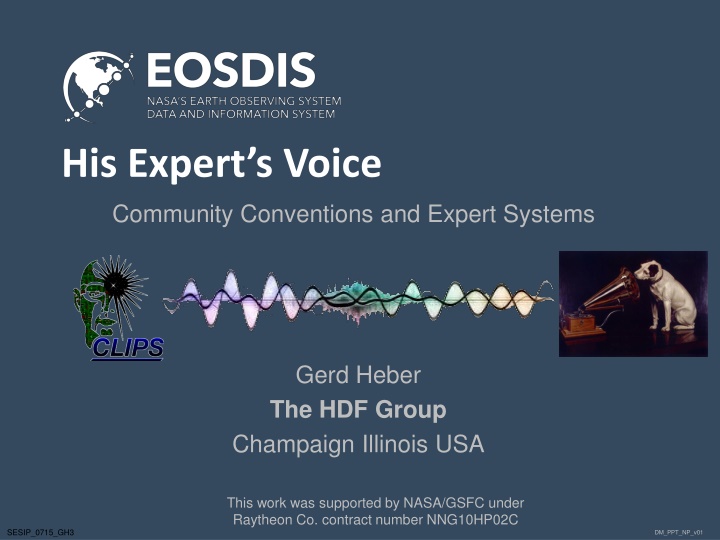
Insights into Expert Systems, Data Modeling Conventions, and Examples
Discover the world of expert systems, data model conventions, and practical examples in this insightful content. Learn about the structure and meaning of data model conventions, the rules and applications of expert systems, and explore examples such as Conway's Game of Life. Dive into the realms of expert system-centric views and gain valuable knowledge on developing high-quality data models.
Download Presentation

Please find below an Image/Link to download the presentation.
The content on the website is provided AS IS for your information and personal use only. It may not be sold, licensed, or shared on other websites without obtaining consent from the author. If you encounter any issues during the download, it is possible that the publisher has removed the file from their server.
You are allowed to download the files provided on this website for personal or commercial use, subject to the condition that they are used lawfully. All files are the property of their respective owners.
The content on the website is provided AS IS for your information and personal use only. It may not be sold, licensed, or shared on other websites without obtaining consent from the author.
E N D
Presentation Transcript
His Experts Voice Community Conventions and Expert Systems Gerd Heber The HDF Group Champaign Illinois USA This work was supported by NASA/GSFC under Raytheon Co. contract number NNG10HP02C SESIP_0715_GH3 DM_PPT_NP_v01
Outline Expert Systems Recap Typical Example An Expert System-centric View of the HDF Product Designer (HPD) Status Work in Progress SESIP_0715_GH3 July 14 17, 2015 2 DM_PPT_NP_v01
Conventions (Idealized) A data model convention defines the structure and intended meaning of data. However, it should also be noted that a data model convention is restrictive rather than permissive. Let me illustrate this with an old joke (well I ve been telling it for a long time) about the differences between different European cultures. It goes like this: What is the difference between the British, the Germans, and the Italians? I don t know, what is the difference? Well, for the British it is allowed unless it is forbidden, for the Germans it is forbidden unless it is allowed, and for the Italians it is allowed especially if it is forbidden. Well data models conventions are like the Germans. It is forbidden unless it is allowed. So if you have not provided the necessary entity types, relationship types, and attributes, then the data cannot be held. Source: Developing High Quality Data Models by Matthew West, Elsevier 2011. SESIP_0715_GH3 July 14 17, 2015 3 DM_PPT_NP_v01
Expert Systems Smokey, this is not Nam. This is bowling. There are RULES. (W. Sobchak) Rule: Red_light IF the light is red THEN stop (IF <LHS> => THEN <RHS>) Rule: Green_light IF the light is green THEN go (<pattern>* => <action>*) SESIP_0715_GH3 July 14 17, 2015 4 DM_PPT_NP_v01
Conways Game of Life 1. A cell adjacent to exactly 2 or 3 other living cells continues to live. 2. Any living cell adjacent to less than 2 or greater than 3 other living cells will die. 3. Any dead cell adjacent to 3 other living cells comes to life. X X X X X X X X X X X X X X X X Gen. N Gen. N+1 SESIP_0715_GH3 July 14 17, 2015 5 DM_PPT_NP_v01
Example (CLIPS Syntax) (deffacts control-information (phase assessment) (phase-after assessment death) (phase-after death birth) (phase-after birth relaxation) (phase-after relaxation assessment)) Ordered Facts -> (deftemplate cell A live cell (slot row (type INTEGER) (range 0 4)) (slot col (type INTEGER) (range 0 4))) <- Fact Template (defrule deaths Living cells with live neighbor count <2 or >3 die (phase death) ?cell <- (cell (row ?row) (col ?col)) ?count <- (live-neighbor-count (row ?row) (col ?col) Rule -> (val ?val&~2&~3)) => (printout t Deleting cell [ ?row , ?col ] crlf) (retract ?cell)) SESIP_0715_GH3 July 14 17, 2015 6 DM_PPT_NP_v01
Convention Knowledge Organization Convention 2 Interop HPD Design Cycle Convention 1 SESIP_0715_GH3 July 14 17, 2015 7 DM_PPT_NP_v01
HPD: Expert System-Centric View CLIPS rules and fact templates provided by domain expert(s) MVC (MVC: Model-View-Controller pattern) SESIP_0715_GH3 July 14 17, 2015 8 DM_PPT_NP_v01
Status and Challenges Conventions in HPD: HDF-EOS w/ ACCD NUG w/ ACCD CF w/ ACDD Custom (experimental) CLIPS integration with a Python-based HPD client via PyCLIPS (unmaintained!) State management (UI, design, facts) The Expert System development process is different from traditional SW development SESIP_0715_GH3 July 14 17, 2015 9 DM_PPT_NP_v01
Work in Progress Documentation HPD Convention Author s Guide HPD Conventions Cookbook Exploring new conventions Improving the development process Weighing technology options SESIP_0715_GH3 July 14 17, 2015 10 DM_PPT_NP_v01
References J.C. Giarratano and G.D. Riley: Expert Systems: Principles and Programming, Fourth Edition, Course Technology, 2004. C. Nikolopoulos: Expert Systems, Marcel Dekker, 1997. http://clipsrules.sourceforge.net/ [Forgy1982] Charles Forgy (1982). "Rete: A Fast Algorithm for the Many Pattern/Many Object Pattern Match Problem". Artificial Intelligence 19 17 37. doi:10.1016/0004-3702(82)90020-0 [Jess] [Jess] http://herzberg.ca.sandia.gov/ [Lisa] [Lisa] http://lisa.sourceforge.net/ [ [LispWorks LispWorks] ] http://www.lispworks.com/ [ [PyCLIPS PyCLIPS] ] http://pyclips.sourceforge.net/web/ [Book1] [Book1] [Book2] [Book2] [CLIPS] [CLIPS] [Forgy1982] 19: SESIP_0715_GH3 July 14 17, 2015 11 DM_PPT_NP_v01
12 SESIP_0715_GH3 DM_PPT_NP_v01
This work was supported by NASA/GSFC under Raytheon Co. contract number NNG10HP02C 13 SESIP_0715_GH3 DM_PPT_NP_v01
